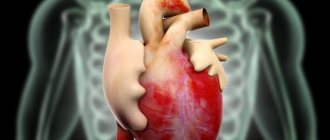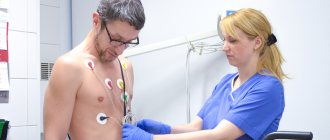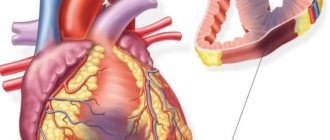Slowing or stopping the conduction of cardiac impulses through the atrial myocardium occurs with coronary artery disease, hypertension, rheumatism, and heart defects. According to the degree of severity, three variants have been identified - from asymptomatic to severe, characterized by complete separation of atrial contractions. The main detection method is ECG. Anticholinergics and sympathomimetics are used for treatment.
What kind of disease is this?
Before you find out how to properly treat the disease, you need to find out what impaired intraatrial conduction means and what is the reason for its development. If even minor changes in the order of heart contractions occur in the body, this can negatively affect the functioning of each organ. This condition indicates that the process of blood flow into the aorta is difficult.
Doctors define several stages of the disease. Depending on the nature of the disorder, the following blockades can be distinguished:
- Incomplete. It can be detected at the initial stage of development of the disease. Its main symptom is the slow transmission of impulses transmitted through the fibers of the heart.
- Full. It is observed in patients who do not follow the doctor’s recommendations, or the therapy was chosen incorrectly. This type is most often incompatible with life and all because the passage of impulses is completely stopped.
The main reason for the disruption of intraatrial conduction may lie in damage to the heart muscles, the presence of defects and coronary artery disease. Smoking and alcohol abuse play an important role in the development of this pathology. An unhealthy lifestyle, stressful situations, and taking medications that stimulate the cardiovascular system have a negative impact on the functioning of the heart.
There are the following types of blockades depending on the location of the pathology:
- interatrial;
- sinoarterial;
- artioventricular;
- intraventricular.
Failures in the functioning of other organs and electrolyte disturbances caused by long-term use of diuretics can also lead to a slowdown in intraatrial conduction.
Classification
Common to all types of sinus node dysfunction:
| Sign | View |
| Due to the occurrence | Primary: joint weakness syndrome, internal |
| Secondary: external | |
| According to the form of manifestation | Sinus bradycardia |
| SU stop | |
| Sinusoatrial (sinoatrial) impulse block | |
| According to the course of the disease | Acute |
| Paroxysmal or paroxysmal | |
| Chronic or permanent | |
| By manifestations | Asymptomatic |
| Symptomatic |
In the case of the development of sinoatrial block, the classification is supplemented by the degree of slowing of the electrical impulse, if it can be verified. Given the complexity of diagnosis, the diagnosis is usually limited to SG dysfunction.
- Grade 1: no symptoms of the disease, no changes on the ECG. The diagnosis is an accidental finding during a targeted study of the functionality of the SU.
- 2nd degree: manifestations of the disease may be absent; periodic loss of atrial contractions (P wave) is determined on the cardiogram.
- 3rd degree: an extremely dangerous condition with a high risk of fatal outcome; according to the electrocardiogram, it is indistinguishable from a complete stop of the SU.
How does the disease affect the functioning of all organs?
If the patient has only partial disturbances of sinoarterial conduction, then there will be no symptoms, but if complete, he may experience chest discomfort and dizziness; these symptoms are provoked by poor blood circulation in the brain.
The interatrial form of the disease is not life-threatening for the patient. But if it is, then the risk of developing atrial fibrillation increases several times, which is already a threat to health. A similar condition manifests itself in the form of shortness of breath at rest or while walking, swelling of the lower extremities, bluish discoloration of the skin, and discomfort in the chest area.
Atrioventricular disturbance of intraatrial conduction only manifests symptoms in some patients, but if bradycardia is additionally observed, then no one is immune from an attack of MAS. At this moment, the patient experiences weakness throughout the body. Dizziness with loss of consciousness and convulsions, which are associated with impaired blood flow in the brain, may occur. This condition requires urgent hospitalization and qualified assistance. If no measures are taken, the patient faces cardiac arrest.
The intraventricular form manifests itself due to difficulty passing blood through the bundle branches. Partial blockage does not always manifest symptoms, but a rare pulse, loss of consciousness and chest discomfort can indicate a complete blockage.
Development mechanism
Slowing of impulse conduction through the atria is a consequence of the death of cells of the sinoatrial or sinus node.
As a result of insufficiently intense production of the bioelectric impulse, weak activity of the myocardium itself is observed. First, only the atria, then the ventricles and the entire muscular organ as a whole suffer.
Read more about intraventricular conduction disorders here.
Up to a certain point, violations are not visible at all; information about the deviation is provided only by electrocardiography, if you look closely.
As it progresses, bradycardia (slow heart rate) develops. The natural pacemaker produces an insufficiently strong signal, and after reaching a critical cell level, threatening consequences develop. The probability of cardiac arrest increases to 70%; only transplantation can save the patient.
The contractility of the myocardium decreases, the volume of pumped blood decreases, therefore all organs and systems suffer from ischemia. Liver and kidney failure, brain hypoxia, and neurological deficits develop.
Death is a matter of time. Fortunately, such a fatal scenario is not a matter of just one year. There are chances for high-quality diagnosis and the prescription of adequate therapy.
What signs should cause you to worry?
What is a violation of intraatrial conduction is already known, what forms of pathology there are, too, but it is important to know how the disease manifests itself in order to seek help in time.
Most often, patients note the following manifestations:
- cardiopalmus;
- disturbances in the functioning of the heart;
- periodic stopping of contractions;
- dizziness;
- fainting;
- angina pain in the heart;
- dyspnea.
If the patient experiences a slowdown rather than a disruption of intraatrial conduction, then symptoms do not always appear. The clinical picture is most pronounced only in the presence of pathology, which provoked such disorders. Some patients complain of rapid fatigue, weakness throughout the body, memory problems, they are often disturbed by a feeling of fear, and their mood changes sharply.
With a complete blockade, the patient has a heart defect, which can only be corrected by a surgeon after surgery. Such problems often occur in newborns. The disease is diagnosed in babies born to a mother who suffers from autoimmune diseases or has problems with the heart and blood vessels.
What methods will help to make a correct diagnosis?
If a patient experiences at least one of the symptoms listed above, then he simply needs to consult a doctor, and perhaps even undergo a full examination in order to identify the disease and immediately begin its treatment. To make a correct diagnosis, you will have to undergo the following types of examinations:
- cardiogram;
- Holter monitoring;
- ECG tests with stress;
- Ultrasound of the heart;
Diagnostics
If even minor manifestations of the disease are detected, the patient should visit an arrhythmologist. If there is no such specialist in your area of residence, you should contact a cardiologist.
Diagnosis of cardiac conduction disorders includes:
- An ECG using the Holter method is the main method that will help identify the degree of disturbance, mark periods of decreased heart rate, and identify the relationship of pathology with the use of medications, as well as with the time of day.
- An electrocardiogram with exercise is a special test on a treadmill or exercise bike, when electrodes are attached to the patient and the relationship of the disorder with physical activity is revealed.
- An ultrasound examination of the heart shows the appearance and structure of heart tissue and helps determine the disease and functionality of the myocardium.
- Laboratory tests of blood and urine.
- Biological and chemical blood test.
- Study of hormone levels.
Additional examination methods are prescribed by the attending physician, based on the individual course of the disease.
Parents who notice shortness of breath, decreased attention, forgetfulness, poor school performance, and recurrent heart pain in their children should be especially attentive. At the slightest suspicion, you must show the child to the doctor, strictly follow his recommendations and undergo all necessary examinations.
Is pregnancy possible with this diagnosis?
Any malfunction that occurs in a woman’s body while carrying a baby can lead to serious and irreversible consequences. Heart problems pose a serious problem for doctors when the fetus and its further proper development are at risk. This disease develops in pregnant women most often against the background of hormonal changes and functional changes.
If a pregnant woman has even a slight disturbance of intraatrial conduction, she needs to go for an ECG as quickly as possible. Diagnostics will help to find out how serious the changes are and will enable specialists to choose the right treatment.
What are the dangers of conduction disorders in the heart?
The danger of such a disorder is based on the fact that there is a risk of developing heart failure, myocardial infarction and atrial fibrillation. This is what a person faces from slowing down and disrupting the intraatrial conduction of the heart:
- angina pectoris;
- pulmonary artery thrombosis;
- attack of MES;
- cerebral ischemia;
- stroke;
- sudden death.
The most dangerous are considered to be MES (Morgagni-Adams-Stokes) attacks, loss of creation and seizures resembling epileptic ones. The severity of symptoms depends on how long the stoppage of ventricular function lasted and the level of heart rate drop. The heart rate may drop by 20 beats or more. During an attack, the pressure level on the tonometer reaches critical levels. A similar condition can occur several times a day, the duration of the attack is about 5 minutes, and cardiac arrest is often observed.
The consequences of the disease are also dangerous for humans. In addition to MES attacks, which lead to the brain not receiving enough oxygen necessary for its functioning, the patient experiences memory impairment, general condition deteriorates, and the level of intellectual abilities decreases. If the partial form of the disease turns into a complete one, this can lead to cardiogenic shock, which without qualified help can result in sudden death.
In order to prevent such serious and irreversible complications, it is important to identify the cause of intra-atrial conduction disturbances in a timely manner. Treatment in this case will give good results.
Complications and prognosis
With partially impaired conduction through the heart, the prognosis is favorable. If a complete blockade of any part of the heart muscle develops, the prognosis is unfavorable, as this can lead to complications - cardiac arrest and sudden death, ventricular fibrillation and thromboembolic complications such as pulmonary embolism and ischemic stroke.
Disorders in childhood
Heart block in children manifests itself with the same symptoms as in an adult, but treatment and prognosis have their own characteristics. Impaired conduction of the heart impulse in children is diagnosed at any age, in the fetus while still in the womb.
The development of the disease in young patients can be provoked by: inhibition of the sinus node and the inclusion of additional pathways that help conduct the signal. But sinus node problems can cause the following conditions:
- myocardial sclerosis;
- myocardial inflammation;
- disruptions in electrolytic balance;
- changes in cellular metabolism.
But in newborns, the following negative circumstances can cause intra-atrial conduction disturbances:
- infection in the womb;
- difficult pregnancy;
- prematurity;
- low birth weight.
All these factors lead to the fact that even during birth, disruptions occur in the baby’s body, including in the cardiovascular system.
Injuries during labor can also trigger the development of the disease, and this is associated with neurovegetative pathways. In such infants, other pathologies are additionally identified:
- psychovegetative;
- motor development disorders;
- neurological.
If a child experiences prolonged blockades, but in a mild form, then treatment is not prescribed. But if there is pain and discomfort, they recommend:
- treatment of the underlying disease with antibiotics and hormonal drugs;
- resuscitation methods are used for acute myocardial infarction and infective endocarditis;
- acute myocarditis is treated with antibiotics and glucocorticosteroids;
- For chronic heart failure, digitalis and diuretics are recommended.
Some drugs that are prescribed to children for the treatment of intra-atrial conduction disorders can block the conduction of impulses through the His leg, so they are either completely discontinued or the dosage is significantly reduced.
Causes cardiac
All factors need to be considered in the system. During the survey, they are excluded one by one.
A sharp increase in blood pressure
If, against the background of chronic hypertension and a gradual increase in blood pressure, the body somehow manages to adapt to new, albeit difficult, conditions, a rapid increase in the tonometer reading leads to overload of the right atrium.
The result is damage to the cells of the sinus node. If such episodes are repeated, and this is exactly what happens against the background of uncorrected hypertension, more and more cells die.
Progression depends on the course of headache. Crises have an even more severe impact.
Inflammation of the heart muscle or myocarditis
It has a detrimental effect mainly on the atria. Without treatment it leads to tissue destruction and severe scarring.
The sinus node is located in the right chamber, and its partial destruction is possible. Slow conduction is a complication of the disease.
The nature of inflammation can be infectious or autoimmune. Both forms are acute, with a pronounced clinical picture of the heart, blood vessels, respiratory and nervous systems.
Treatment is strictly in a hospital. Endocarditis is a similar pathological process affecting the inner lining of the heart. Less often it leads to a slowdown, but this is also possible.
Coronary insufficiency
Narrowing or blockage of special arteries that supply the heart itself. Tissue necrosis is a variant of the condition. Another is possible. The so-called angina pectoris.
It is not so catastrophic; there is death, but the process does not reach that critical point when destruction leads to damage to large areas.
May last for years. It flows spasmodically. In waves. Each episode destroys part of the myocardium. The result is insufficiency and dysfunction. The sinus node suffers not least.
In addition to the death of cardiomyocytes, scarring of the impulse pathways occurs. The so-called bundle of His and its branches (legs), which leads to blockade.
Atherosclerosis of the coronary arteries or aorta
The essence of the process is the formation of cholesterol plaques that close the lumen of blood vessels. Blood flow weakens, pressure in the atria and ventricles increases.
How the growth of the indicator ends is with an increase in load and tissue destruction at the cellular level.
There is another variant of pathology - narrowing of the lumen of the arteries. This is the result of smoking, vasculitis, when the walls of blood vessels scar and close, alcohol abuse, and other autoimmune pathologies.
Treatment is urgent, conservative in the first stages. If ineffective, surgical intervention is indicated.
Heart attack
Acute circulatory disorder in the heart muscle. Leads to rapid destruction of cardiomyocytes. The process is avalanche-like, the longer the ischemia is observed, the more significant the area of destruction.
Major heart attacks are almost guaranteed to result in death. Even with colossal luck, the process will not pass without a trace. Heart regeneration is impossible. The affected tissue is replaced by scar tissue, unable to contract or create impulse. The result is ischemic disease.
Therapeutic measures
Individual treatment is selected for each patient. All concomitant ailments, body characteristics, age, and health status of the patient are taken into account.
There are several stages of treatment, but the most popular is medication. It helps slow down the progression of the disease if it is detected at an early stage. To correct the patient’s condition, a vitamin-mineral complex is recommended. Often in these cases, experts recommend Preductal. To prevent the disease from progressing to a more severe form, calcium antagonists, thrombolytics and anticoagulants are necessarily used. There are other, no less effective drugs that have helped more than one patient stop the development of the disease:
- magnesium and potassium preparations;
- anti-ischemic drugs;
- adrenomimetics;
- beta blockers.
You will also need medications that help improve blood flow in the brain. In addition, the patient needs to change his usual lifestyle; it is important to strictly follow a diet that will help reduce blood cholesterol levels.
Violation of intraatrial and intraventricular conduction is treated with glycosides. Their use is recommended for all patients who have been given a similar diagnosis. If the intraventricular form of the disease occurs with the atrioventricular one, then these drugs should be taken with extreme caution and be sure to monitor the process using an electrocardiogram.
Extracardiac causes
Other factors also play a role, although they are not directly related to the heart. They are easier to correct, and there is the possibility of completely eradicating conduction disorders:
- Cardioversion performed. Prescribed to patients with paroxysmal tachycardias and other arrhythmias. The procedure involves placing electrodes and passing a charge through the heart.
A side effect is a slowdown in conduction due to dysfunction of the sinus node. Correction using medications.
This is a reversible condition. The acute period requires resuscitation, but this phenomenon occurs relatively rarely.
- Compression of the neck at the level of the carotid sinus. As a result of wearing clothes with a tight collar, tie, jewelry. The process is also reversible, but threatening acute variants of the condition are possible. Nocturnal cessation of breathing or apnea. It develops in patients with ENT problems, obese people, and severe snoring. Heart pathologies in this category of people are a proven fact. The condition needs to be corrected as soon as possible.
- Stroke affecting the subarachnoid space. Violation of cardiac activity is a purely reflex act associated with dysfunction of the parasympathetic region of the autonomic nervous system. Requires urgent medical attention. A prerequisite for the development of deviations is bleeding. The same effect is observed in traumatic brain injuries with the formation of a hematoma.
- Prolonged or improper use of certain medications. Particularly dangerous are cardiac glycosides, calcium antagonists, beta-blockers, neuroleptics, anxiolytics (tranquilizers), mood stabilizers, psychotropic drugs in general, opioids, narcotic analgesics, corticosteroids in inappropriately large dosages, and others. Correction of the treatment regimen or replacement of drugs is required.
- Excessive amount of potassium in the body. Excessive consumption takes its toll. It is difficult to achieve such a concentration with food; most likely, the patient is taking drugs like Asparkam.
- Excess calcium in the bloodstream. The result of leaching of mineral salt from bones. Observed in cases of cancer and prolonged immobilization. Osteoporosis. The nutritional factor does not play a role.
- Intoxication with salts of heavy metals, tumor decay products (for cancer, especially advanced ones).
- Increased intracranial pressure (hypertension caused by impaired outflow of cerebrospinal fluid).
Factors are taken into account in the system. Diagnostics puts an end to the issue. It is extremely rare that no cause is found. Then they talk about the idiopathic form. May be revised in the future.
Forecast
If the patient has only the first degree of blockade, then the prognosis for him is favorable. During it, no serious deviations in well-being have been observed for several years. If the disorder is accompanied by other diseases, such as ischemia, inflammation or cardiosclerosis, then disruptions in rhythm are possible. In these cases, the incomplete form often turns into a complete form.
The second degree is accompanied by atrial arrhythmias: tachycardia, atrial fibrillation, and others. The disease is severe, and the prognosis can only be determined in the presence of underlying pathologies. Atrial dissociation rarely allows the patient to be completely cured, even if all symptoms are eliminated. In severe forms of heart disease, disturbances can be observed several hours before death, so there is absolutely no time to help the person.
It is impossible to predict how long a person with serious disabilities will live, because everything depends on what kind of life he leads and what concomitant diseases he has. But it is important to remember that in any case you should not give up; constant monitoring and taking the necessary medications will make it possible to prolong life and make it more fruitful.
Treatment
Therapy consists of restoring cardiac conduction and hemodynamics of the body. An elderly person with suspected blockade is hospitalized in a hospital, especially with the development of Morgagni-Adams-Stokes syndrome.
Drug therapy for acute conditions:
- Taking anticholinergic drugs: platifilin, atropine, glucose.
- To enhance the sympathetic effect on the impulse conducting system, norepinephrine, ephedrine, alupent, and isadrine are prescribed.
- Hydrocortisone is used to relieve inflammation, swelling, and reduce potassium content in the signal transmission area.
- Lasix helps reduce potassium levels.
If medication is ineffective, doctors install an electrode in the right ventricle. Cardiac pacing is indicated for myocardial infarction with complete blocking of the signal.











